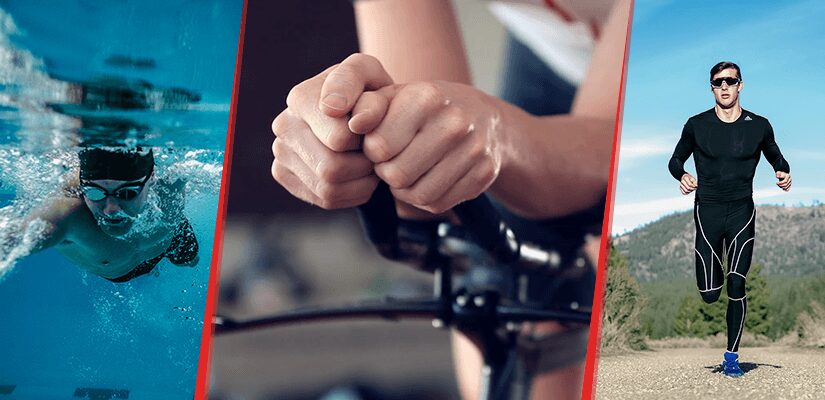New Triathlon Base Training Plans

Our triathlon training plans have been used to prepare athletes around the globe for their winning performances, but up until now they have only focused on one-third of the triathlon equation: cycling. This is all changing, starting with our new Base triathlon training plans, which include comprehensive swim, bike and run instructions.
Overview
Our original Triathlon Specialty Blocks were designed for athletes who would be swimming and running in conjunction with their on-the-bike training. Our Base and Build plans, on the other hand, were more general. While they weren’t designed specifically for triathletes, the lower volume options still served as fantastic plans for triathletes that wanted to get faster. That said, we knew we wanted the triathlon training plans we offered next to be fully comprehensive from start to finish. Now they are just that.
Our new Triathlon Base training plans (revamped Build and Speciality tri plans coming soon) have been designed from the ground up for multi-sport athletes. With workouts for swim, bike and run disciplines, our goal is to help triathletes get as strong as possible for all aspects of their event.
Chad Timmerman, our Level I USAC and USAT certified Head Coach who designs TrainerRoad’s training plans and workouts, uses RPE as the method of measurement for all his prescribed swim and run workouts. Specifically, the swim workouts use RPE and distance to quantify each interval and the running workouts use RPE and time.
With nearly a decade of coaching experience and large amount of research under his belt, Coach Chad has designed four Base-specific triathlon training plans. Take a look at each new plan below.
Sprint Triathlon Base
Sprint triathlons require a very different approach than the increasingly common Half- and Full-Distance triathlons. The short duration of these events generally requires a high-level of intensity — something to start training for from the beginning.
Sprint Base Low Volume
- Duration: 4 weeks
- Swim volume: 33-44 minutes/week
- Bike volume: 89-127 TSS/week
- Run volume: 50-60 minutes/week
Sprint Base Mid Volume
- Duration: 4 weeks
- Swim volume: 93-109 minutes/week
- Bike volume: 170-230 TSS/week
- Run volume: 105-130 minutes/week
Sprint Base High Volume
- Duration: 4 weeks
- Swim volume: 130-210 minutes/week
- Bike volume: 219-332 TSS/week
- Run volume: 177-200 minutes/week
Olympic Triathlon Base
Effectively managing your training time begins to get difficult when you step into the Olympic distance. It is crucial for athletes competing in this international distance to develop their threshold power in all disciplines, since this is where they will spend most of their time on race day.
Olympic Base Low Volume
- Duration: 6 weeks
- Swim volume: 46-61 minutes/week
- Bike volume: 126-152 TSS/week
- Run volume: 70-105 minutes/week
Olympic Base Mid Volume
- Duration: 6 weeks
- Swim volume: 92-116 minutes/week
- Bike volume: 154-208 TSS/week
- Run volume: 125-175 minutes/week
Olympic Base High Volume
- Duration: 6 weeks
- Swim volume: 161-191 minutes/week
- Bike volume: 231-359 TSS/week
- Run volume: 155-195 minutes/week
Half-Distance Triathlon Base
Athletes training for half-distance triathlons need to build a broad aerobic base while paying attention to intensities at or above threshold. Whether you are a time-constrained athlete, or somebody looking to PR your next event with plenty of available training time, these plans will effectively build your endurance in all three triathlon disciplines.
Half-Distance Base Low Volume
- Duration: 8 weeks
- Swim volume: 84-123 minutes/week
- Bike volume: 186-298 TSS/week
- Run volume: 85-160 minutes/week
Half-Distance Base Mid Volume
- Duration: 8 weeks
- Swim volume: 99-132 minutes/week
- Bike volume: 216-394 TSS/week
- Run volume: 135-190 minutes/week
Half-Distance Base High Volume
- Duration: 8 weeks
- Swim volume: 146-204 minutes/week
- Bike volume: 258-442 TSS/week
- Run volume: 160-225 minutes/week
Full-Distance Triathlon Base
Although full-distance triathlons are considered an endurance event, the low-volume variation of this plan still gives you the fitness you need in the always-critical Base Phase. Ranging from 4-5 days of training per week, this plan will take 12 weeks to establish a lasting and reliable base of aerobic fitness.
Full-Distance Base Low Volume
- Duration: 12 weeks
- Swim volume: 95-154 minutes/week
- Bike volume: 186-372 TSS/week
- Run volume: 90-215 minutes/week
Full-Distance Base Mid Volume
- Duration: 12 weeks
- Swim volume: 103-179 minutes/week
- Bike volume: 196-452 TSS/week
- Run volume: 150-250 minutes/week
Full-Distance Base High Volume
- Duration: 12 weeks
- Swim volume: 158-243 minutes/week
- Bike volume: 278-565 TSS/week
- Run volume: 170-285 minutes/week
As mentioned above, our new Build and Speciality triathlon training plans including swim, bike and run instructions will also be available soon. Keep an eye out. In the meantime, if you have any questions, feel free to leave them in the comment section below.